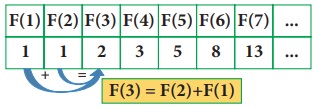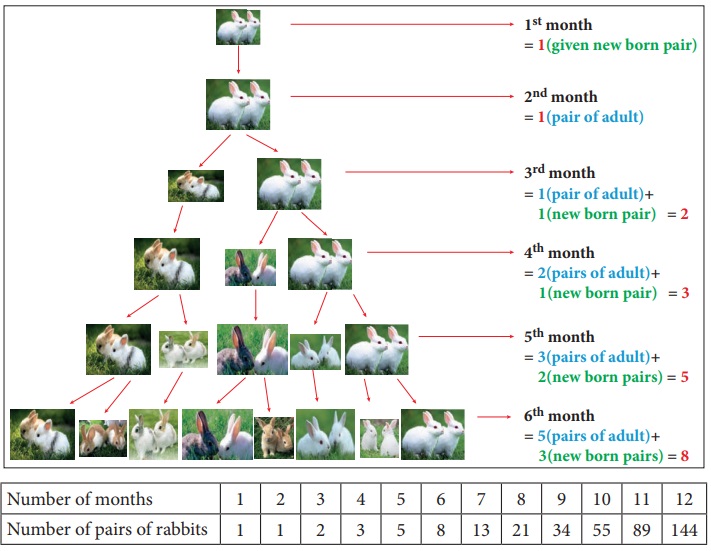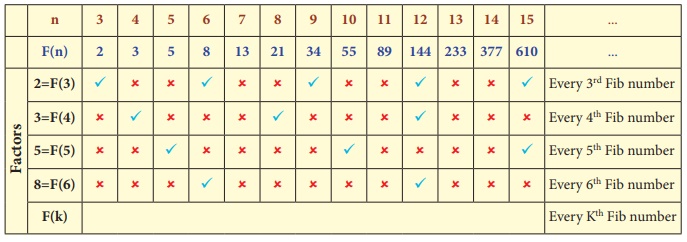Information Processing | Chapter 7 | 8th Maths - Fibonacci Numbers | 8th Maths : Chapter 7 : Information Processing
Chapter: 8th Maths : Chapter 7 : Information Processing
Fibonacci Numbers
Fibonacci
Numbers
We have learnt
in earlier classes, on how all beautiful things in nature as well as man made things
are connected with Mathematics. Now, we just refresh everyone’s memory and show
how Math can be beautiful when seen in physical and biological things everywhere
around us.
Fibonacci
(real name Leonardo Bonacci) was an Italian mathematician who developed the Fibonacci
Sequence. Remember the pattern of the Fibonacci sequence we already studied in standard
VI it looks like this: 1, 1, 2, 3, 5, 8, 13, 21, 34... and it goes on.
Let us tabulate
the Fibonacci sequence and find a rule.

We observe
that the 3rd term of the Fibonacci
sequence is the sum of 2nd
term and the 1st term.
That is,
F(3) = F(2) + F(1) and so we can extend
and write the rule is

F(n)= F(n–1) + F(n–2)
where F(n) is the nth term
F(n–1) is the previous term to the nth term
F(n–2) is the term before the (n–1)th term
This is how the Fibonacci Sequence is obtained. Let us learn more from the following real life examples.
Situation:
Let us look at the family tree of a male drone bee and a female bee as shown Fig 7.19.
Here, female
bees have 2 parents, male (drone) bees have just one parent, a female. (Male bee
(drone) are produced by the queen’s unfertilized eggs, so male(drone) bees only
have a mother but no father!)

From the
picture the following points are noted:
1. The male ![]() has 1 parent, a female
has 1 parent, a female ![]() .
.
2. The male ![]() has 2 grandparents
has 2 grandparents ![]() , since his mother had parents
, since his mother had parents ![]() , a male and a female.
, a male and a female.
3. The male ![]() has 3 great-grandparents
has 3 great-grandparents ![]() : since his grandmother has two parents
but his grandfather has only one.
: since his grandmother has two parents
but his grandfather has only one.
Now, answer,
how many great-great-grandparents did the male ![]() have?
have?
Let us try
to find the relationship among the pattern of bees family by representing in the
tabular form given below,

We see the
Fibonacci numbers 1, 1, 2, 3, 5, 8, 13… in the above table.
Note
The difference between two
consecutive numbers of the Fibonacci sequence increase very quickly. ((For example
F(5) – F(4) = 5 – 3 = 2 ; F(10) – F(9) = 55 – 34 = 21 ; F(15) – F(14) = 610 – 377
= 233)(1, 1, 2, 3, 5, 8, 13, 21, 34, 55, 89, 144, 233, 377, 610, 987, 1597, 2584,
4181, 6765, 10946 ...))
Example 7.7
Given that
one pair of new born rabbits they produce a new pair each month and from the second
month, each new pair can breed themselves. Find how many pairs of rabbits are bred
from one pair in a year, and find the relationship between the number of months
and the number of pairs of rabbits by tabulation (a pair means (a male and a female)).
Solution:
The below
picture clearly forms the sequence is 1,1,2,3,5,8...
Here, we find the pattern in which each number is in the Fibonacci sequence, obtained
by adding together with previous two. Going on like this to find subsequent numbers
at the twelfth month, we will get 144 pairs of rabbits. In the other words,
twelfth Fibonacci number is 144.

Activity
Using the given Table I, find the pattern, answer the following questions
and colour the values in the given Table II. One is done for you.
Table I

1. Where are the even Fibonacci Numbers? Colour both the term n and
where F(n) is even in yellow. Do you find any pattern? Every Third Fibonacci number is
a multiple of 2(even).
2. Where there are Fibonacci numbers which are multiple of 3 ? Colour both the term n and where F(n) is multiple of 3 in red.
Write down the pattern you find
Every 4th Fibonacci number is a multiple of 3.
3. What about the multiple
of 5? Colour both the term n and
where F(n) is multiple of 5 in blue. Write down the pattern
you find.
Every 5th Fibonacci number i.e. a multiple of F(5) or 5 = F(5)
4. What about the multiple
of 8? Colour both the term n where
F(n) is multiple of 8 in green. Write down the pattern you find.
Every 6th Fibonacci number i.e a multiple of F(6) or 8 = F(6)
Table II

From the above activity, we conclude that
Every Fibonacci number is a factor of (a term number of) Fibonacci
numbers in miltiples.

From the above table, we get a general rule as Every kth Fibonacci number is a multiple of F(k).

Related Topics